
Government bunker (Germany)
Encyclopedia
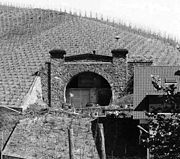
Germany
Germany , officially the Federal Republic of Germany , is a federal parliamentary republic in Europe. The country consists of 16 states while the capital and largest city is Berlin. Germany covers an area of 357,021 km2 and has a largely temperate seasonal climate...
, officially named Ausweichsitz der Verfassungsorgane des Bundes im Krisen- und Verteidigungsfall zur Wahrung von deren Funktionstüchtigkeit (AdVB), in English: Emergency Seat of the Federal Constitutional Organs for the State of Crisis or State of Defence
State of Defence (Germany)
The term State of Defence refers to the legal status of the Federal Republic of Germany if it is "under attack by armed force or imminently threatened with such an attack". This special status, which was created by a constitutional amendment in 1968, gives the Federal Government extraordinary...
to Maintain their Ability to Function was a massive underground complex designed to house the German government, parliament and all federal personnel needed to keep the government working in the event of war or severe crisis. Located only about 25 km south of Bonn
Bonn
Bonn is the 19th largest city in Germany. Located in the Cologne/Bonn Region, about 25 kilometres south of Cologne on the river Rhine in the State of North Rhine-Westphalia, it was the capital of West Germany from 1949 to 1990 and the official seat of government of united Germany from 1990 to 1999....
, Germany
Germany
Germany , officially the Federal Republic of Germany , is a federal parliamentary republic in Europe. The country consists of 16 states while the capital and largest city is Berlin. Germany covers an area of 357,021 km2 and has a largely temperate seasonal climate...
(the capital and government seat of pre-unification West Germany), in the Ahr Valley
Ahr
Ahr is a river in Germany, a left tributary of the Rhine. Its source is at an elevation of approximately 470 metres above sea level in Blankenheim in the Eifel, in the cellar of a timber-frame house near the castle of Blankenheim...
between the towns of Ahrweiler
Ahrweiler
Ahrweiler is a district in the north of Rhineland-Palatinate, Germany. It is bounded by the districts Euskirchen, Rhein-Sieg and the city Bonn in the state North Rhine-Westphalia, and the districts of Neuwied, Mayen-Koblenz and Vulkaneifel.- History :The region was conquered by the Romans under...
and Dernau
Dernau
Dernau is a municipality in the district of Ahrweiler, in Rhineland-Palatinate, Germany.The village of Dernau which is centrally located in the Ahr valley is famous for its wines. Most of them are red wines. Besides agriculture, tourism is a strong economic factor, which is growing rapidly....
, it was one of the best kept secrets of West Germany. It was built between 1960 and 1972 inside two abandoned railway tunnels, maintained and kept in a working condition for about 30 years and decommissioned in 1997. A small part of the once-secret site is now open to the public as Government Bunker Documentation Site, while the vast majority is abandoned and sealed.
History
The bunker complex below the vineyards and forests along the river Ahr was built inside two disused railway tunnels of a former strategic railway line built in preparation of World War IWorld War I
World War I , which was predominantly called the World War or the Great War from its occurrence until 1939, and the First World War or World War I thereafter, was a major war centred in Europe that began on 28 July 1914 and lasted until 11 November 1918...
but never entered into service. After the war, during years of recession, the German state railway company lost interest in the line which was of no economic value and finally abandoned it.
Between 1930 and 1939 the disused railway tunnels were used to farm mushrooms to gain independence from having to import French fungi. During the later phase of World War II several arms manufacturing companies occupied the tunnels and a huge concentration camp for forced labourers was erected outside the protective cover of the tunnels, which was also referred to under the code name Lager Rebstock (Camp Vine). Inside the tunnels was a construction facility for manufacturing ground equipment and mobile launch pads for the V-2 rocket
V-2 rocket
The V-2 rocket , technical name Aggregat-4 , was a ballistic missile that was developed at the beginning of the Second World War in Germany, specifically targeted at London and later Antwerp. The liquid-propellant rocket was the world's first long-range combat-ballistic missile and first known...
. With increasing Allied air raids at the end of the war, the tunnels served as make-shift air-raid shelters.
Construction and Interior Design
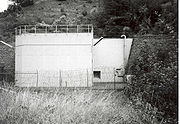
Construction of the bunker began in 1960 and lasted until 1972. The government bunker, also known by the neutral-sounding name Dienststelle Marienthal (Office Marienthal) was constructed inside the existing tunnels which had never been used for the purpose they had initially been built for. Additional tunnels of a total length of 17.3km were driven and blasted into the soft slate mountains along the Ahr Valley to build an emergency seat for the federal government that would allow up 3,000 people to survive an attack for at least 30 days. At the time of construction the total length of all tunnels probably amounted to 19km.
The facility was designed to withstand attacks with nuclear weapons and was fitted with autonomous supplies of electric power, fresh air and drinking water. Unlike other fortifications or military bunkers, however, there were no defence systems and it would have been protected by military units stationed nearby. The costs of construction were estimated at about DM 3 million, although no precise figures are known due to the high level of secrecy.
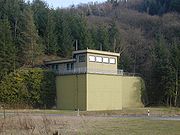
The bunker built beneath 110m of slate rock consisted of two sections named Ost (East) and West which were separated by a valley and connected by a 60m deep passageway. The eastern section was partitioned again into two independent parts (Ost/West and Ost/Ost) and the western section into three parts (West/West, West/Mitte [Centre] and West/Ost), each with tunnels parallel to and crossing the main tunnels. All tunnels were concrete-lined and most had two floors, with several exits and emergency escape routes. The main portals were sealed by manoeuvrable steel and concrete gates built by MAN, each weighing 25 tonnes. The bunker housed 897 offices and 936 dormitories and had 25,000 doors in total. It even had an underground hairdresser's salon.
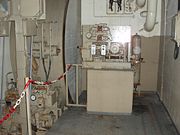
In the event of a defence situation the bunker would have accommodated the federal president, the chancellor, the joint defense committee, the president of the constitutional court, various ministries as well as civilian and military personnel. Briefings would have been held in large conference and map rooms situated next to the chancellor's office. Part of the A61
Bundesautobahn 61
is an autobahn in Germany that connects the border to the Netherlands near Venlo in the northwest to the interchange with A 6 near Hockenheim. In 1965, this required a re-design of the Hockenheimring....
motorway (Autobahn) near the village of Gelsdorf had been designed for use as a runway and would have been used as an airport for the bunker with spacious aircraft parking spaces at both ends disguised as roadside car parks.
Every two years exercises took place in the bunker as part of NATO WINTEX whereby staff actually worked inside the hermetically sealed bunker for up to 30 days. Such exercises, for instance, involved the passing of bills by an emergency parliament of 22 members, including a mock chancellor and president. The bunker was used for the first time in October 1966 during the course of the NATO high command exercise FALLEX 66, and for the last time in 1987. The Berlin Wall
Berlin Wall
The Berlin Wall was a barrier constructed by the German Democratic Republic starting on 13 August 1961, that completely cut off West Berlin from surrounding East Germany and from East Berlin...
came down two years later.
About 180 staff working in three shifts were required for maintaining, repairing and operating the bunker. In 2008 it became publicly known that the shelter would have just about withstood the detonation of a 20 kiloton bomb, comparable to the destructive force of the Hiroshima bomb. Secret surveys conducted as early as 1962 had found that 250-times more powerful weapons were to be expected and it had been made clear that the bunker would collapse if ever hit by a nuclear bomb. Despite this known fact, however, construction was continued for political reasons.
Dismantling of the Bunker
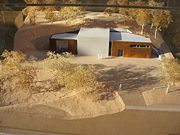
The Documentation Site
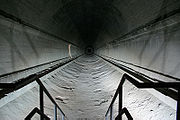
Ahrweiler
Ahrweiler is a district in the north of Rhineland-Palatinate, Germany. It is bounded by the districts Euskirchen, Rhein-Sieg and the city Bonn in the state North Rhine-Westphalia, and the districts of Neuwied, Mayen-Koblenz and Vulkaneifel.- History :The region was conquered by the Romans under...
and have been converted into a museum of the cold war
Cold War
The Cold War was the continuing state from roughly 1946 to 1991 of political conflict, military tension, proxy wars, and economic competition between the Communist World—primarily the Soviet Union and its satellite states and allies—and the powers of the Western world, primarily the United States...
. It was opened on February 29th, 2008. The Federal Government of Germany still owns this remaining part of the bunker and has invested €2.5million for its conversion into a museum. The investment was approved because the estimated costs of €30million for deconstruction were undercut considerably, costing only €16million in total.
The Dokumentationsstätte Regierungsbunker museum (Government Bunker Documentation Site) feeatures a cinema, the entrance to former section 1 (Ost/Ost) and 203m of tunnel more or less in its original condition. Visitors can see the two MAN gates as well as the air locks used to bypass them with the corresponding decontamination rooms, followed by several steel doors and several offices and dormitories. A partially authentically furnished medical unit is also on display. Original equipment from the bunker and guided tours help imagine what life in the bunker once was like. The museum ends with a view into the fully gutted tunnel.
Literature
- Bundesamt für Bauwesen und Raumordnung/Stiftung Haus der Geschichte der Bundesrepublik Deutschland: Der Regierungsbunker. Ernst Wasmuth Verlag, Berlin/Tübingen 2007, ISBN 978-3-8030-0671-4.
External links
- www.ausweichsitz.de: Comprehensive information about the bunker museum
- Facts and photos of the government bunker (in German)
- A website about the bunker by photographer Andreas Magdanz
- The government bunker and its relevance during the cold war (in German)
- Latest news about the museum on the website of Alt-Ahrweiler e.V (in German)

